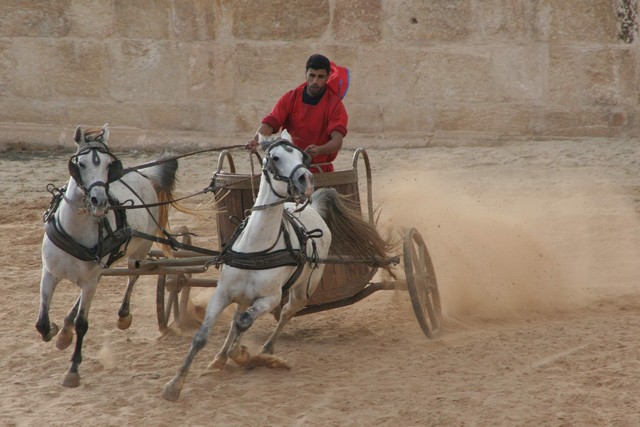Hope you like the new header! It’s from a reenactment of a Roman chariot race in Jordan. The photo was taken by John Bayley, a family friend and photographic genius.
Dear 7X,

Sorry I’m away on an excursion today. I’ll be back next week with a gruesome historical whodunit about the death of Claudius. I won’t tell you here why it’s gruesome. Suffice to say, I find myself having to explain a number of rather unpleasant words whenever I run the activity. Violent death and the ancient Romans – they go together somehow.
Don’t forget, by the way, to hand in your excursion forms for next Wednesday. Throw yourself on the mercy of the ladies in the office if you’ve lost the one I gave you.
Now to ancient Rome. There’s an introduction below, followed by some pictures and, at the bottom of this post, some relaxing activities. You deserve them. Leave a comment if you discover anything blood-curdling!
THE ROMANS…
The BBC website describes the Romans as “ingenious but brutal”. I think this is a succinct and accurate description. The Romans built superbly designed roads, triumphal arches and aqueducts and administered a massive empire for hundreds of years, but despite their brilliance in many fields they certainly had a brutal streak.
The Romans are remembered for many qualities, not all of them pleasant. They are famous for their military conquests; for their cruel punishments, such as the one inflicted on Jesus and the thousands of slaves they executed for rebellion along the Appian Way; for the blood sports in their amphitheatres, where by all accounts they bayed for blood and got it; and for the decadence they displayed during their huge banquets. These are just a few examples.
Nevertheless, their influence on the modern world has been immeasurable, like that of the ancient Greeks. Most modern languages have many words that originate from Latin; the script used by the Romans is the one used in most countries for writing today; the administrative methods, architecture and engineering of the ancient Romans have been admired and emulated ever since their empire finally collapsed.
The Western Roman Empire officially came to an end in 476AD, a date that is usually considered to mark the end of the ancient period and the beginning of the medieval period. This depends on which historian you read, of course.
Ironically and paradoxically, even though they were in many ways warlike and vicious, they imposed upon their large empire an enforced peace. Even in the midst of all their decadence, the learning and ideas that flourished during that time of peace (known as “Pax Romana”) provided a basis for later civilisations to build upon.
But you don’t need to worry about all that today! You can just chill out, become a gladiator, design a mosaic or do another activity in the box below the pictures. Be nice to your sub.
Kind regards,
Ms Green.

Our family friend, John Bayley, took this shot of a reenactment of a Roman chariot race during his visit to Jordan last year. I hope it gets you in the mood for gladiators and blood sports.
 Reenactment of a Roman legion in formation, taken by John Bayley during his trip to Jordan this year.
Reenactment of a Roman legion in formation, taken by John Bayley during his trip to Jordan this year.
Click HERE for the Gladiator: Dressed to Kill Game from the wonderful BBC website if you haven’t have played this game already. (You can also click on the pic below.)
Roman Mosaics: The Romans loved to make pictures with small tiles. Click HERE for some pictures of Roman mosaics to inspire you. Then try making your own by clicking on my mosaic below to go to a site that lets you design one online.
Click HERE to view a Roman mosaic of a dog – you will love it.
A Roman Street
Toss everything that doesn’t belong in a Roman street into the time tunnel in this game from the BBC. Click HERE.
The History of Pizza
Read this interesting story by clicking HERE.
 David looks up at the Colosseum in 1995.
David looks up at the Colosseum in 1995.
 Reenactment of a Roman legion in formation, taken by John Bayley during his trip to Jordan this year.
Reenactment of a Roman legion in formation, taken by John Bayley during his trip to Jordan this year.Click HERE to view a Roman mosaic of a dog – you will love it.
A Roman Street
Toss everything that doesn’t belong in a Roman street into the time tunnel in this game from the BBC. Click HERE.
The History of Pizza
Read this interesting story by clicking HERE.
 David looks up at the Colosseum in 1995.
David looks up at the Colosseum in 1995.

